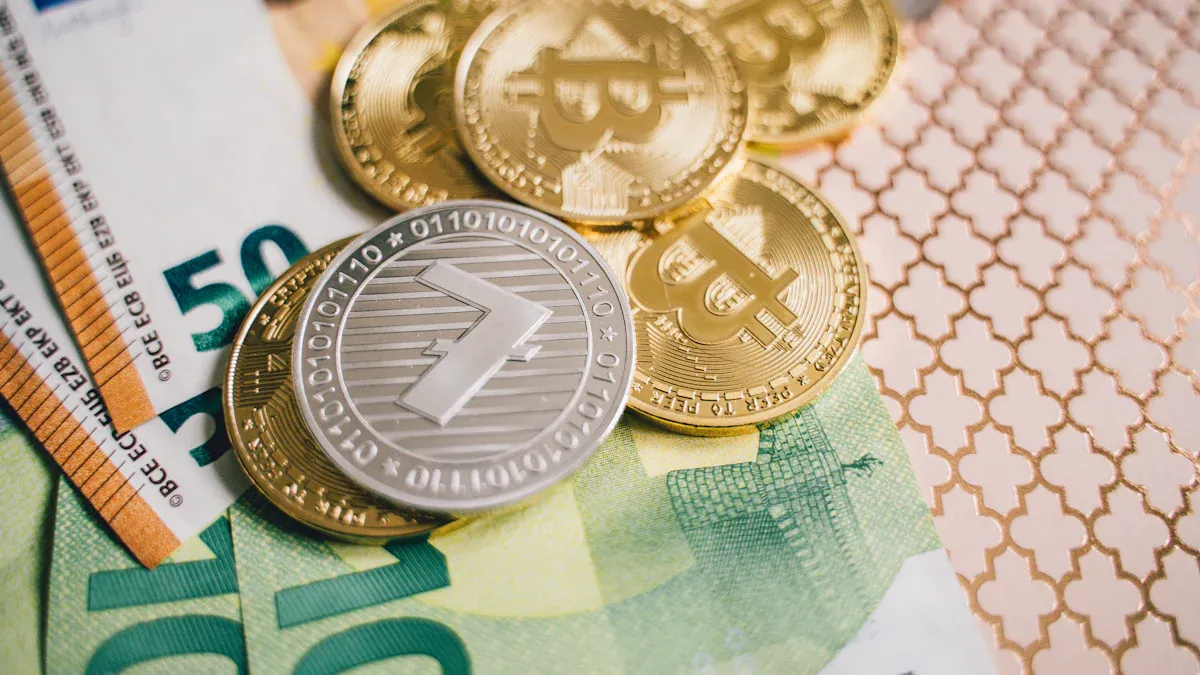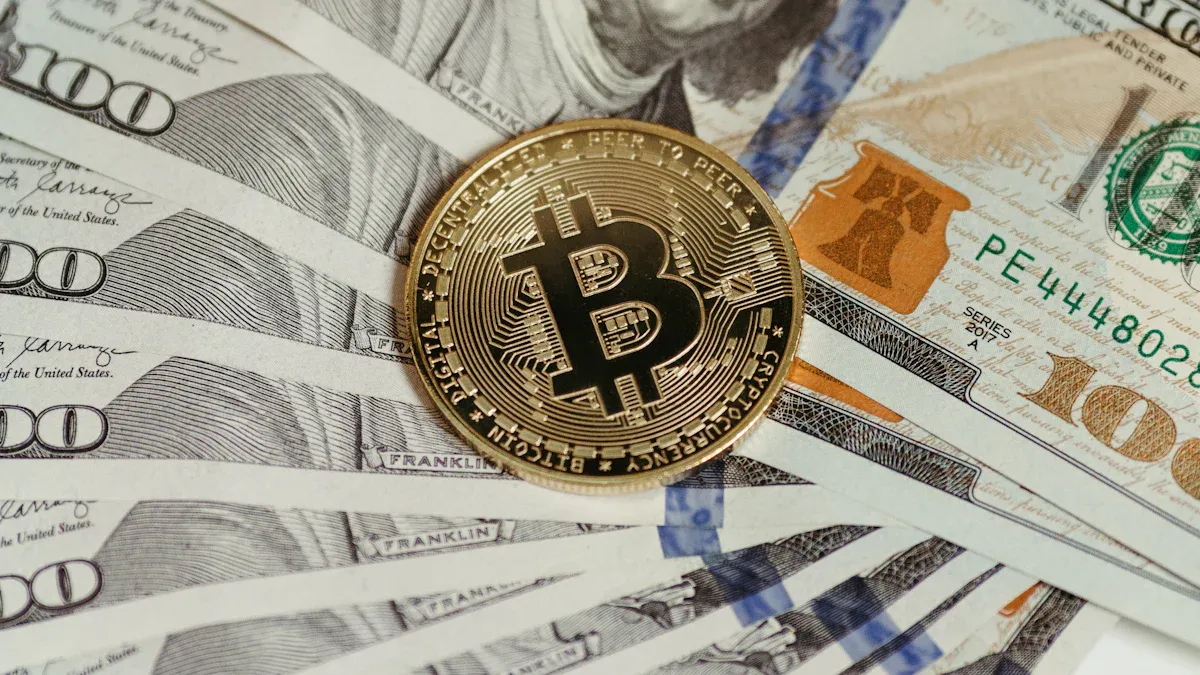- EasyCard
- Trade
- Help
- Announcement
- Academy
- SWIFT Code
- Iban Number
- Referral
- Customer Service
- Blog
- Creator
Beyond Traditional USD Settlement: Stablecoin Payments Unlock New Opportunities in Foreign Trade

Image Source: pexels
A payment in transit for several days is a common frustration for foreign trade business owners. Traditional wire transfers via theSWIFT network usually take3 to 5 business days to arrive, and high intermediary bank fees further erode already thin profits.
Change has arrived: Stablecoin payments, with their near-real-time settlement efficiency and extremely low transaction costs, are giving enterprises a competitive edge. Successful stablecoin payment practices are a key step for businesses to enhance competitiveness amid global trade disruptions.
Key Takeaways
- Traditional foreign trade settlement methods are slow, expensive, and risky, no longer meeting the demands of modern global trade.
- Stablecoin payments are a new approach that enables fast fund arrival with very low fees, acting like digital USD.
- Choosing a good payment service provider is important; it can help verify transaction safety and legality, avoiding risks.
- Enterprises can start trying stablecoin payments with small transactions, then gradually integrate them into company fund management.
- In the future, stablecoin payments will combine with new technologies like smart contracts, making global trade more efficient and intelligent.
Traditional Settlement Dilemmas: Why Foreign Trade Enterprises Urgently Need New Solutions

Image Source: pexels
For global trade enterprises, the traditional USD settlement system is increasingly becoming a constraint on development. Its inherent inefficiency and high costs, combined with drastic changes in the global trade environment, have collectively created an urgent demand for new settlement solutions.
The “Three Big Mountains” of Traditional USD Settlement
Foreign trade enterprises generally face three insurmountable obstacles in traditional settlements: high costs, long waits, and uncontrollable risks.
- High Costs: An international wire transfer passes through multiple intermediary banks. Each bank chargesprocessing fees ranging from $15 to $50. These fees accumulate layer by layer, significantly eroding enterprise profit margins.
- Low Efficiency: Funds in transit typically take 3 to 5 business days. This delay ties up valuable enterprise cash flow, affecting turnover speed and business opportunity capture.
- Frequent Risks: Payment delays or even failures occur from time to time. Bank systems may reject transactions for various reasons, commonly including:
- Incorrect recipient account information
- Anti-money laundering (AML) or Know Your Customer (KYC) review failures
- Transaction party information matching sanction lists
These uncertainties bring additional operational risks and communication costs to enterprises; every returned or delayed payment can impact client relationships.
New Settlement Challenges Amid Global Trade Disruptions
In recent years, geopolitical and trade policy changes have brought new shocks to traditional settlement systems.The SWIFT system was once seen as neutral financial infrastructure, but now it is increasingly used as a geopolitical tool.Excluding banks from certain countries or regions from the SWIFT network directly disrupts normal settlements for enterprises doing business with those areas.
At the same time,the restructuring of global trade routes and frequent tariff policy adjustments have also introduced new compliance challenges. Enterprises need to quickly adapt to financial regulations, currency controls, and tax requirements in different countries and regions. This regulatory uncertainty demands more flexible and resilient fund management strategies, which the rigid processes of traditional settlements clearly cannot meet.
Stablecoin Payments: A Cost-Reduction and Efficiency-Boosting Tool for Foreign Trade Settlements

Image Source: pexels
Facing the heavy obstacles of traditional settlements, stablecoin payments offer a clear path to cost reduction and efficiency gains. It is not just a technical tool but a strategic weapon for foreign trade enterprises to reshape fund efficiency and global competitiveness.
What Are Stablecoins and How They Work
A stablecoin is a special digital currencywhose value is pegged 1:1 to a stable asset (usually the USD). This allows it to act as a “digital USD” in global trade, with the most well-known examples being Tether (USDT) and USD Coin (USDC).
The core value of stablecoins lies in their “stability.” They maintain price stability througha mechanism similar to a currency board. Specifically, issuers promise to hold sufficient high-quality reserve assets to ensure every issued stablecoin is backed by equivalent real-world assets.
Reserve assets are key: According to public reports, mainstream stablecoin issuers’ reserves have shifted from higher-risk commercial paper to safer assets. For example,Tether’s reserve composition shows most assets are highly liquid US Treasury bonds.
This fully collateralized model ensures users can redeem stablecoins for fiat at a 1:1 ratio anytime. When market prices deviate slightly, arbitrageurs quickly buy or sell to pull the price back to the peg. It is this credible redemption promise and transparent reserve mechanism that gives stablecoins the potential to replace traditional USD in cross-border payments.
Case Comparison: Traditional Wire Transfer vs. Stablecoin Payment
To intuitively demonstrate the disruptive advantages of stablecoin payments, we compare a $100,000 payment using traditional wire transfer versus stablecoin.
Scenario: A mainland China exporter needs to collect $100,000 from a US client.
- Traditional Wire Transfer (SWIFT)
- Process: Funds leave the US client’s bank account, pass through 1-3 intermediary banks, and finally arrive at the exporter’s licensed bank account in Hong Kong.
- Time: The entire process usually takes 3-5 business days, excluding weekends and holidays.
- Cost: Remittance banks, intermediaries, and receiving banks all chargefees, totaling potentially $400-$600 or more. Funds are unusable during transit.
- Stablecoin Payment (USDT Example)
- Process: The US client uses a compliant payment provider likeBiyapay to convert USD to USDT, then sends it directly via blockchain (e.g., TRON) to the exporter’s digital wallet.
- Time: Transaction confirms in minutes, funds arrive near-real-time, 7x24 hours year-round.
- Cost: Blockchain transfer fees are extremely low. On TRON, a transaction typically costs under $1. Even with provider conversion fees, total cost is far below traditional wires.
The chart below clearly shows the huge gap in cost and efficiency.
| Metric | Traditional Wire (SWIFT) | Stablecoin Payment (USDT) |
|---|---|---|
| Settlement Time | 3–5 business days | Within minutes |
| Total Fees (Estimate) | $400 - $600+ | As low as single-digit USD (excluding conversion) |
| Availability | Bank business days only | 7x24x365 anytime |
Successful stablecoin payment practices have already delivered real benefits. Reports show one import-export company reducedcross-border SME payment costs by 40% after adopting stablecoins, greatly boosting profits and competitiveness.
Global Regulatory Trends and Application Prospects
As stablecoin adoption grows, global regulators are shifting from observation to active legislation, integrating them into compliance frameworks, paving the way for safe enterprise adoption.
- EU: Issued the Markets in Crypto-Assets Regulation (MiCA), setting clear authorization, reserve, and transparency requirements for stablecoin issuers.
- US: Advancing bills like the GENIUS Act to establish federal licensing and regulation for payment stablecoins, requiring 100% cash or cash-equivalent reserves.
- Singapore: Launched a single-currency stablecoin framework requiring strict reserve, capital, and audit standards for Singapore-issued stablecoins.
Additionally,the Financial Action Task Force (FATF) and other international bodies have issued guidelines requiring stablecoin service providers (VASPs) to comply with the same AML and CFT rules as traditional institutions,such as conducting customer due diligence (CDD) and reporting suspicious transactions.
Regulatory maturation means stablecoins are leaving the “wild growth” era. For foreign trade enterprises, this means more compliant, transparent, and reliable stablecoin payment solutions in the future, with broader prospects in global trade settlements.
Stablecoin Payment Practices: Mastering Compliance and Risk Control
Although stablecoin payments show huge potential in efficiency and cost, enterprises must face core challenges when adopting: compliance and risk control. Successful stablecoin payment practices are not simple send/receive operations but comprehensive solutions built on robust risk control systems. Without effective risk management, enterprises may face fund freezes, legal sanctions, or reputational damage.
Core Challenges: Transaction Authenticity and AML Compliance
For B2B foreign trade enterprises, stablecoin payments face two major risk control challenges.
First is transaction background authenticity. Every cross-border payment must correspond to real international trade activities. Regulators require providers to prove fund flows are linked to legitimate goods or services. Without verification, funds may be suspected of money laundering, terrorist financing, or other illicit activities.
Second is anti-money laundering (AML) compliance. Blockchain anonymity facilitates illegal transfers. Thus, FATF and others require stablecoin providers to fulfill AML obligations equal to traditional institutions, including:
- Know Your Customer (KYC): Thorough identity verification of both parties.
- Transaction Monitoring: Continuous behavior monitoring to identify suspicious patterns.
- Address Screening: Compare counterpart wallet addresses against global sanction lists and risk databases.
If a provider cannot effectively address these, B2B stablecoin payment practices carry huge risks. Received funds linked to high-risk addresses may lead to frozen digital wallets or bank accounts.
Practice Analysis: On-Chain and Off-Chain Dual Risk Control Model
To address these, leading providers developed an “on-chain + off-chain” dual risk control model combining traditional trade audits with emerging blockchain analytics for complete B2B stablecoin compliance. Take compliant platformBiyapay as example; its risk control flow:
- Off-Chain Trade Background Verification:
- Enterprises submit trade documents like purchase orders, commercial invoices, bills of lading before initiating/receiving payments.
- Biyapay’s system automatically reviews document authenticity and consistency, ensuring legitimate trade backing.
- On-Chain Fund Behavior Analysis:
- Platform uses blockchain tools to deeply scan payer wallet addresses.
- System traces fund sources, analyzes historical transactions, cross-references with blacklisted, mixer, or dark web addresses. High-risk funds are auto-blocked.
By precisely matching off-chain verified trade info with on-chain confirmed “clean” funds, the platform builds a complete evidence chain per transaction. This dual model is key to safe, compliant stablecoin payment practices.
How to Choose a Reliable Payment Service Provider
Choosing a reliable provider is the first and most important step for successful stablecoin payments. Enterprises should focus on:
- Compliance Credentials and Regulatory Recognition A compliant provider must hold necessary licenses in key markets. In the US, stablecoin regulation is forming at state and federal levels. Choose platforms embracing regulation and seeking licenses.
- State-Level: Providers need state financial regulator licenses, like New York’s BitLicense. Frameworks must be"substantially similar" to federal standards.
- Federal-Level: Directly supervised by federal agencies, replacing state licenses.
- Compliance Commitment: Even in unclear regions, providers should proactively follow FATF guidelines, building strict AML/CFT systems.
- Strong Dual Risk Control Capabilities Check for the “on-chain + off-chain” model described. Ask about specific audit processes, document verification, and on-chain analysis tools. Platforms like Biyapay clearly demonstrating risk logic and tech strength are more trustworthy.
- Transparent Fee Structure Reliable providers offer clear fees, including fiat-stablecoin conversion, withdrawal fees. Beware vague or hidden fee platforms.
- Stable Technology and Customer Support Platforms need 7x24 stable operation and professional support teams. Timely, effective help is crucial for transaction issues.
In summary, mastering compliance and risk control is core to stablecoin payment practices. Choosing a provider with strong compliance and tech strength is a wise move for foreign trade enterprises to seize opportunities while avoiding risks.
Embrace Change: Seize Stablecoin Payment Opportunities
After recognizing stablecoin advantages and risk points, how should foreign trade enterprises seize this change? The answer is not full upheaval but gradual, strategic integration. From pilots to integration to future embrace, enterprises can maximize stablecoin potential in phases.
Start with Small-Scale Trials for Stablecoin Collections
For most enterprises, the safest start is small, high-frequency transactions. This helps teams familiarize with processes and verify efficiency in controlled risks. Basic steps for stablecoin collections:
- Choose Stablecoin: Prioritize widely accepted ones like USDT or USDC.
- Set Up Digital Wallet: Create a secure wallet for receiving, holding, sending stablecoins.
- Understand Regulations: Ensure all digital asset activities comply with local laws.
- Integrate Payment Provider: Partner with reliable providers like Biyapay to simplify tech docking and compliance, lowering barriers.
Through regulated channels, enterprises candeposit received stablecoins like cash, laying foundation for fund management.
Integrate into Enterprise Global Fund Management Strategy
Once stablecoin processes mature, seamlessly integrate into existing global treasury systems. This is not just adding a payment option but systemic treasury efficiency upgrade.
Successful integration requiresfour core components: secure custody and wallet infrastructure, stable blockchain network access, settlement APIs, and tools for multi-currency conversion and automated reconciliation.
Leading ERP systems like SAP offer Digital Currency Hubs. These auto-handle stablecoin statements, reconcile with invoices, and include balances in overall cash positions like traditional bank accounts.
Future Outlook: Smart Contracts and Asset Tokenization
Stablecoin payments’ future extends beyond settlement. Two key technologies—smart contracts and real-world asset (RWA) tokenization—will bring deeper global trade changes.
- Smart Contracts: Smart contracts auto-execute payments when conditions are met (e.g., goods arrive at port).This automation eliminates delays, reduces errors and disputes.
- Asset Tokenization: In the future,inventory, warehouse receipts, even receivables can be “tokenized” as blockchain digital assets. Financial institutions can finance based on these credible tokens, greatly improving SME cash flow and reducing supply chain financing costs.
Embracing stablecoin payments means embracing a more efficient, transparent, intelligent global trade future.
Stablecoin payments are not just technological innovation. They are a strategic choice for foreign trade enterprises to boost competitiveness amid global trade shifts.Traditional settlement inefficiencies and high costs have created urgent demand for new solutions.
Stablecoin payments, with disruptiveefficiency and cost advantages, provide clear answers. As global regulatory frameworks and risk controls mature, adopting stablecoins is no longer risky. It is a key step for enterprises to proactively explore, layout the future, and gain global market advantages.
FAQ
Is it legal to use stablecoins for collections in mainland China?
Enterprises should operate through payment providers with overseas compliant licenses. These providers convert stablecoins to fiat within compliance frameworks and settle to designated bank accounts (e.g., Hong Kong licensed banks). The entire process ensures fund chain compliance; enterprises do not directly hold or trade digital currencies.
What is the biggest risk of stablecoin payments?
The biggest risk is unintentionally receiving funds from unknown or illegal sources, leading to account freezes.
Solution: Choosing providers with strong risk control is crucial. Their “on-chain + off-chain” dual audits effectively block high-risk funds, ensuring transaction safety.
Do stablecoin prices fluctuate? How to ensure fund safety?
Mainstream stablecoins (like USDT, USDC) are 1:1 pegged to USD with minimal fluctuations. Enterprises choose reputable, transparent-reserve stablecoins and use compliant platforms for instant conversion to maximize price risk avoidance and fund safety.
What does the total cost of stablecoin payments include?
Total costs mainly consist of two parts:
- Blockchain Network Fees: Usually under $1 for on-chain transfers.
- Provider Fees: Platforms charge conversion and withdrawal service fees.
Even including service fees, total costs are typically far below traditional wire intermediary fees.
*This article is provided for general information purposes and does not constitute legal, tax or other professional advice from BiyaPay or its subsidiaries and its affiliates, and it is not intended as a substitute for obtaining advice from a financial advisor or any other professional.
We make no representations, warranties or warranties, express or implied, as to the accuracy, completeness or timeliness of the contents of this publication.




Contact Us
Company and Team
BiyaPay Products
Customer Services
is a broker-dealer registered with the U.S. Securities and Exchange Commission (SEC) (No.: 802-127417), member of the Financial Industry Regulatory Authority (FINRA) (CRD: 325027), member of the Securities Investor Protection Corporation (SIPC), and regulated by FINRA and SEC.
registered with the US Financial Crimes Enforcement Network (FinCEN), as a Money Services Business (MSB), registration number: 31000218637349, and regulated by FinCEN.
registered as Financial Service Provider (FSP number: FSP1007221) in New Zealand, and is a member of the Financial Dispute Resolution Scheme, a New Zealand independent dispute resolution service provider.




















